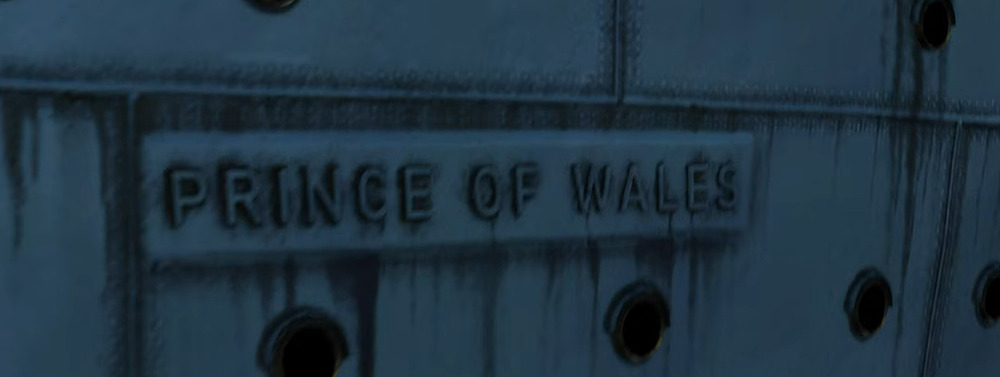- Yes
- Yes, for premium
- Yes, for event / gift
- No
History:
The battleship Prince of Wales was laid down on January 1, 1937 at the Cammell-Laird shipyard in Birkenhead. Launched on May 3, 1939, and entered service on March 31, 1941.
Prince of Wales was one of the latest and most popular types of battleships of the British Navy. The battleship Prince of Wales took part in many famous battles of the Second World War throughout her service.
Continuation of the story:
Spoiler
Battle in the Denmark Strait with Bismarck
Already on May 22, 1941, the Prince of Wells went to sea to intercept the German battleship Bismarck. During this operation, the same famous battle took place in which the battle cruiser Hood was lost. The battleship also received serious damage; in fact, only one tower remained combat-ready and the British decided to retreat.
The Prince of Wells was too new a ship, for which she suffered. However, already in his first short battle he inflicted significant damage on his opponent. The exhausted artillerymen, fighting more with their guns than with the Germans, did not suspect that they had decided the outcome not of this battle, but of the entire battle.
Some of the shells that hit the battleship did not explode. In particular, the Bismarck shell, which hit the battleship below the waterline and pierced the side, did not explode inside the ship. The reason is the low speed of the projectile before hitting; before that, it had to overcome about 30 meters under water. The shell fuse did not work, but the ammunition laid out its intricate ricochet path. Damaging structural elements, equipment and other unarmored components in the area of impact. Leaving behind traces of penetration of bulkheads with both round and oval holes, depending on the angle of intersection of the projectile trajectory. It was precisely such minor, non-critical damage to various parts of the ship that collectively determined the complete loss of the battleship’s combat effectiveness. The Bismarck shell was found lying around during initial emergency work after the battleship left the battle. All unexploded enemy ammunition found on the battleship was thrown overboard.

Diplomatic mission
After the battle with Bismarck, the battleship was under repair until July 1941. In August 1941, he returned to duty and took part in the diplomatic mission. missions. On board the battleship, British Prime Minister W. Churchill arrived in the United States at the naval base of Argentia, on the island of Newfoundland.
An important personal meeting with US President F. Roosevelt took place here, codenamed Riviera. The result of this meeting was their adoption of the Atlantic Charter, which proclaimed aspects of the post-war world order. A particularly important point was that a decision was made on military assistance to the USSR in the war against Germany.



Connection Z
Subsequently, Prince of Wales was included in the Eastern Fleet and on October 25 set sail for the Far East. On November 28, the battleship linked up with the battlecruiser Repulse in Colombo. On December 2, 1941, British ships under the command of Admiral Tom Phillips arrived in Singapore becoming the basis of Task Force Z.
Force Z consisted of Prince of Wales, Repulse and four destroyers: Electra, Express, Vampire and Tenedos. The commander of the formation, Admiral Phillips, asked the commander of the British Air Force in the Far East, Air Vice-Marshal Palfield, to cover his ships with fighters. The British air force in this region numbered 158 aircraft in service and 88 in reserve, including Brewster F2A Buffalo fighters, quite suitable for covering ships. However, Palfield refused to provide cover aircraft, apparently trying to preserve aviation for the defense of Singapore. This circumstance later played a fatal role.
Last stand at Kuantan
On the eve of the war with Japan, the British Admiralty sent Force Z to Singapore: the battleship Prince of Wales and the battlecruiser Repulse under the command of Admiral Tom Phillips. As British Prime Minister Winston Churchill recalled, it was sent to those waters to create “the uncertain threat that first-class battleships, the whereabouts of which are unknown, may pose to all the naval plans of the enemy.”
Force Z arrived on December 2, and a week later, when Great Britain was already at war with Japan, it was decided in London that both ships “should go to sea and get lost among the countless islands.” It was impossible to carry out this intention, since Phillips had already left Singapore to intercept a Japanese troop convoy spotted off the southern coast of Indochina. At the same time, the admiral was warned about the concentration of large forces of enemy aircraft in that area. Nevertheless, he decided to launch a surprise attack on the Japanese landing forces and then quickly withdraw.
Alas, this plan failed even at the beginning of its implementation. The Royal Air Force command informed the admiral that it could not provide fighter cover for the squadron. Phillips nevertheless decided to continue the hike. He hoped that surprise would ensure his success. However, already on the afternoon of December 9, the Japanese submarine I-65 noticed connection Z, reporting it by radio.
The message about the presence of enemy battleships in the landing area alarmed the Japanese command. Aircraft were immediately scrambled to search for British ships. But his fears were in vain: Phillips turned back when he was informed about the appearance of Japanese air reconnaissance aircraft. The Admiral led Force Z back towards Singapore. He soon changed course upon receiving reports that the Japanese were landing at Kuantan, right in the center of the Malay Peninsula. Here fate gave Phillips a chance of salvation, since the area was accessible to British fighters. But unfortunately for the admiral, no one thought to send them there.


On the morning of December 10, the squadron arrived at Kuantan, but the news of the Japanese landing turned out to be false. But it soon became clear that the area was being patrolled by enemy planes looking for British ships. The Prince of Wales received a radio message from one of the destroyers they attacked. The squadron prepared to repel an air attack, turning towards Singapore. At 10:20 she was noticed by a Japanese reconnaissance aircraft, which notified the strike group, consisting of 30 bombers and 54 torpedo bombers, that the targets had been detected.

Already during the first attack, the torpedo bombers managed to hit the Prince of Wales twice. The consequences were catastrophic: part of the battleship’s engine rooms was flooded, and the steering failed. “Repulse” first showed miracles of dexterity, dodging the deadly “cigars”. But the luck was short-lived: one of them jammed its rudders, and then three more hit both of its sides. Since the old battlecruiser was not prepared for such damage, she suffered a strong list and capsized at 12:33. Along with him, 513 sailors out of 1,309 crew members died.
Meanwhile, Phillips’ flagship was torpedoed four more times. Its speed dropped to eight knots, but the crippled battleship was still afloat. At 12:44 he was attacked by bombers, causing further damage. At 13:10 it became clear that the Prince of Wales was doomed, and her commander John Leach ordered the crew to abandon ship. The battleship sank ten minutes later. The escorting destroyers managed to rescue 1,285 people out of 1,612 crew members. Neither Leach nor Admiral Phillips were among them.
According to Churchill, during the entire war he had never received “such a knockout blow” and December 10, 1941 became an important date both for Great Britain and for the whole world. The British Prime Minister was right: for the first time in history, aviation independently dealt with battleships at sea. This day marked the end of an era when big gunships dominated the seas.
Technical characteristics:
- Displacement - standard 38,600 mt, full load 44,500 mt.
- Length - only 227.1 m (225.6 m at waterline)
- Beam - 31.4 m
- Draft - 10.4 m
- Engines - of 8 Admiralty type steam boilers, 4 Parsons turbines
- Power - 110,000 hp
- Propulsion - 4 screws
- Speed - 28 knots (tested in 1941)
- Crew - 1422 people
Armor:
- Deck Strap - 152 mm above magazine, 127 mm above equipment.
- Barbettes - 355 mm
- Bulkheads - 305 mm
- Turret face armor - 330 mm
- Turret side armor - 228 mm
- Rear turret armor - 177 mm
- Turret top armor - 152 mm
- Conning tower - 102 mm
Spoiler


Armament:
(December 1941)
- 2x4 - 356mm BL (14-inch) Mark VII
- 1x2 - 356mm BL (14-inch) Mark VII
- 8x2 - 133mm QF (5.25-inch) Mark I guns
- 5x8 - 40 mm QF (2-pounder) Mark VIII “Pom-Pom” guns
- 1x4 - 40 mm QF (2-pounder) Mark VIII “Pom-Pom” guns
- 1x1 - 40 mm Bofors gun.
- 8x1 - Oerlikon 20 mm guns
- Seaplanes - 2 x Supermarine Walrus.
Scheme:
Spoiler
Historical photographs of a 40 mm Bofors mounted on the stern of a battleship:
Model of the battleship at the time of December 1941:
Spoiler
More photos:
Spoiler







Source:
- BATTLESHIP PRINCE OF WALES Compiled by José M. Rico
- Dispatch on the loss of H.M. ships Prince of Wales and Repulse.
- Loss of H.M. ships Prince of Wales and Repulse. Battle Summary No. 14.
- Death of a Battleship. The Loss of HMS Prince of Wales, December 10, 1941.
- Antony Preston; Jane’s Fighting Ships of World War II, Bracken Books London (ISBN: 9781851701940)
- Kofman V.L. Battleships of the King George V class. – Moscow “Eastflot”, 2007, - 109 p.
- Angus Konstam; British Battleships (2) Nelson & KGV classes (ISBN;9781846033896)
- Roskill S.W. The War At Sea, 1939-1945. — London: HMSO, 1954-1961
- R.A.Burt; British Battleships 1919 - 1945, Seaforth Publishing (ISBN: 8601200795783)
- Alan Raven; Ensign 1, King George Fifth Class Battleships, Bivouac Books LTF (ISBN;9780856800023)























